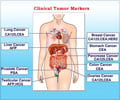A new study analyzed the association between DNA viruses and human malignancies and questioned the claims that more than 40 percent of cancers are caused by viruses.

To better understand the role of DNA viruses in human cancers, researchers from the MD Anderson Cancer Center in Houston sequenced RNA from 3775 malignant tumor samples from The Cancer Genome Atlas and then applied a robust bioinformatics algorithm to survey them for the presence of viral transcripts.
Those cancers not associated with DNA viruses included acute myeloid leukemia, cutaneous melanoma, low and high-grade gliomas of the brain (the latter killed Senator Edward Kennedy), and adenocarcinomas of the breast, colon and rectum, lung, prostate, ovaries, kidneys, and thyroid.
The findings, says Xiaoping Su, an author on the study, suggest the estimate that 40 percent of tumors are virus-related "should be much lower."
"The search for virus associations in these malignancies has consumed the efforts of many investigators," says Su, implying that his large-scale effort will spare researchers fruitless investigations.
The study also provides the framework for understanding how viruses integrate into cancer subtypes such as hepatocellular cancer, says Su. That might make it possible to personalize treatments by targeting genes that are located within known integration sites and that might be drivers of cancer initiation and progression. A key finding was that there are specific sites where viruses integrate into the host genome prior to initiating cancer, and that these sites are frequently located within particular host genes.
Advertisement
Advertisement













